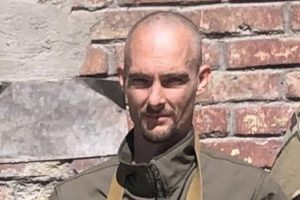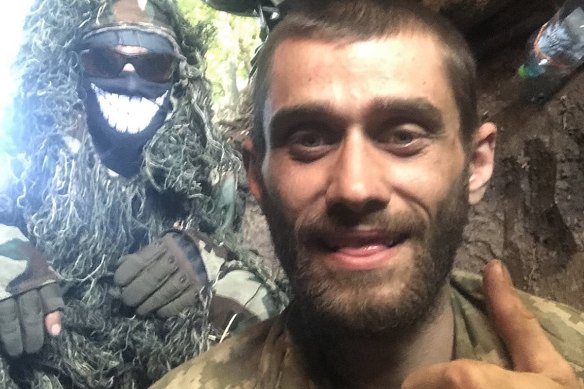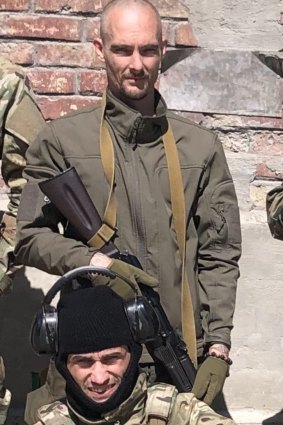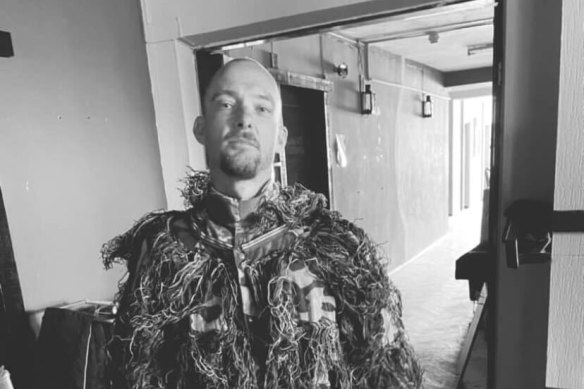‘Stuff this’: How an Australian answered a Facebook ad to fight in Ukraine

Mykolaiv: When would-be soldiers are rejected from Ukraine’s foreign legion, most turn around and go home.
But that’s not what Queensland landscaper Trevor Kjeldal did when told he couldn’t join the Ukrainian military unit.
Trevor Kjeldal (left) and James Durose (right) in Ukraine.
“Stuff this, we’re going to go further into Ukraine and we’ll find a battalion,” Kjeldal told two of his new mates who were also rejected.
Kjeldal, who was known to his comrades in Ukraine as “Ninja” for his stealthiness on the battlefield, on Wednesday became the second Australian in his unit to die fighting on the frontline of Ukraine’s war with Russia.
The 40-year-old’s family have been left attempting to comprehend what happened to their “treasured” loved one.
Kjeldal was among those inspired by Volodymyr Zelensky’s call to arms to foreign fighters around the world when the Ukrainian president announced the creation of the International Defence Legion of Ukraine.
The military unit’s name conjured up images of the international brigades who fought for the Spanish Republic against the fascists in the 1930s.
“When I heard that Zelensky was calling out for volunteer fighters I booked my ticket straight away. I was really inspired by the Ukrainian people’s bravery and resilience,” Kjeldal told Nine News in July.
Ukraine’s Foreign Minister Dmytro Kuleba has said some 20,000 foreign fighters from 52 countries have applied to join the fight.
Trevor Kjeldal (top) with James Durose (bottom) were rejected by Ukraine’s military unit due to their lack of experience.
No official figures are available on how many Australians are fighting in Ukraine but previous estimates put the number at between 200 and 600, despite warnings from the Australian government not to travel to the country.
Kjeldal had no military experience, only a will to go to the frontline to fight Russia.
British welder James Durose first met Kjeldal at the Polish-Ukrainian border.
“How are ya?” the Australian said to Durose, 29, as he was being questioned by Ukrainian border guards.
Durose and Kjeldal, along with an American, then went to stay at one of the bases of the newly created foreign legion.
Trevor Kjeldal pictured while in Ukraine.
But given their lack of military experience, the three men were rejected.
That’s when Kjeldal told the two others they should soldier on and find another battalion to join.
“Me, Ninja and a lad from America set off further east,” says Durose, who returned to Britain after sustaining head injuries on the battlefield in September.
“We had a really hard look trying to find a battalion at first. I think we were out there for about eight weeks without a battalion.”
The three men ended up in the north-eastern city of Kharkiv and came across an advertisement on Facebook for the Carpathian Sich Battalion, which was welcoming foreign fighters.
They were accepted, and after completing a month of training in Kyiv they were sent to the frontline in the country’s north-east.
The central task of the unit was to liberate the city of Izyum, which had been under Russian occupation since the early days of the invasion.
“We did a big attack that managed to push forward to Izyum so we managed to take all of Izyum,” Durose says.
“That’s what we had been fighting for since getting on the frontline, that was our target. And that’s all me and Ninja used to say to each other: ‘Izyum is coming, we’re going to take Izyum’. And we did.”
But it wasn’t without huge losses to their unit.
Kjeldal was seriously injured in mid-July after coming under heavy fire from a small group of Russian soldiers.
While the Australian was in hospital in Kyiv, Durose was in a trench with another Australian, medic Jed Danahay who was also from Queensland, when Russian soldiers ambushed them.
“He [Danahay] got killed right next to me,” Durose says.
“We were in a firefight, I was in a trench with Jed at the time. The Russian approached us from behind, he must have been about 10 metres away… I’ve looked at Jed and said: ‘Is that one of our guys?’ And he looked and said, ‘I don’t know, is it?’”
“I done what I needed to do with that guy, but we didn’t know there was another [Russian] guy behind him… the guy behind him shot Jed straight through his chest, and got a British guy straight through the head.”
“It was a pretty bad day, but we achieved great things from that attack, that’s how we managed to push through to Izyum from that attack.”
A few weeks later, Durose was injured in a tank attack and returned to Britain to recover from his head injuries. But his friend Kjeldal decided to return to the frontline.
“I beat the odds once so let’s just see if I can do it again, I suppose,” Kjeldal said in July.
Durose says his last conversation with his friend was shortly after he returned home to Britain.
“Glad you’re back,” Kjeldal told Durose, letting him know that it had gone relatively quiet on the frontline after the unit took Izyum.
But then on Wednesday, Kjeldal and a man from Taiwan, Tseng Sheng-kuang, were at the top of a hill when Russian tanks zeroed in on them and fired. Both men were killed.
Kjeldal had become close to Tseng as he spoke his language; the Australian had a Chinese wife and daughter who still both live in China.
The soldiers he served with say Kjeldal constantly thought about his wife and daughter.
“He was always sending them money, even though he was going through the hardest times,” Durose says.
“He had a heart of gold. He always had the best intentions. He was also a very comical lad, he was a funny guy.
“It was an honour to get to know the guy. From having no military experience he became a very good soldier.”
Get a note directly from our foreign correspondents on what’s making headlines around the world. Sign up for the weekly What in the World newsletter here.
Most Viewed in World
From our partners
Source: Read Full Article



